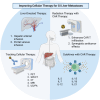Tracking cellular therapies to optimize homing against liver metastases
- PMID: 40636106
- PMCID: PMC12238001
- DOI: 10.3389/fimmu.2025.1611861
Tracking cellular therapies to optimize homing against liver metastases
Abstract
Novel cellular therapies have shown practice changing results in a range of hematologic malignancies, though success against solid tumors has been limited. Key factors limiting success of these therapies against solid tumors are homing to the site(s) of disease, engraftment, maintenance of function, and persistence. The inhospitable tumor microenvironment appears to provide barriers at every step of this process. The liver, a unique organ with diverse immunoregulatory functions, is a common site for metastatic disease from solid cancers of the gastrointestinal (GI) tract. Although the complex interplay between hepatocytes, circulatory and tissue resident immune cells, and the enterohepatic circulation has been investigated for some time, many unanswered questions about the immunobiology of the liver remain. More so, novel imaging techniques provide unparalleled insight into these interactions and shed light on these complex processes that can lead to an improved understanding of the tumor microenvironment in the liver and opportunities for improving homing of cellular therapy against liver tumors. In this review, we will provide a focused assessment of this burgeoning field and focus on the emerging tools for studying homing of these therapies and how they may be enhanced to better treat liver metastases.
Keywords: cancer immunotherapy; cellular therapy; chimeric antigen receptor; immune cell tracking; liver metastases; regional therapy.
Copyright © 2025 Purl, Shick, Canter and Judge.
Conflict of interest statement
The authors declare that the research was conducted in the absence of any commercial or financial relationships that could be construed as a potential conflict of interest.
Figures

Similar articles
-
The Black Book of Psychotropic Dosing and Monitoring.Psychopharmacol Bull. 2024 Jul 8;54(3):8-59. Psychopharmacol Bull. 2024. PMID: 38993656 Free PMC article. Review.
-
Short-Term Memory Impairment.2024 Jun 8. In: StatPearls [Internet]. Treasure Island (FL): StatPearls Publishing; 2025 Jan–. 2024 Jun 8. In: StatPearls [Internet]. Treasure Island (FL): StatPearls Publishing; 2025 Jan–. PMID: 31424720 Free Books & Documents.
-
The Lived Experience of Autistic Adults in Employment: A Systematic Search and Synthesis.Autism Adulthood. 2024 Dec 2;6(4):495-509. doi: 10.1089/aut.2022.0114. eCollection 2024 Dec. Autism Adulthood. 2024. PMID: 40018061 Review.
-
A rapid and systematic review of the clinical effectiveness and cost-effectiveness of paclitaxel, docetaxel, gemcitabine and vinorelbine in non-small-cell lung cancer.Health Technol Assess. 2001;5(32):1-195. doi: 10.3310/hta5320. Health Technol Assess. 2001. PMID: 12065068
-
NIH Consensus Statement on Management of Hepatitis C: 2002.NIH Consens State Sci Statements. 2002 Jun 10-12;19(3):1-46. NIH Consens State Sci Statements. 2002. PMID: 14768714
References
Publication types
MeSH terms
LinkOut - more resources
Full Text Sources
Medical

